The Importance of Lean Meats In Raw Diets
8/30/16
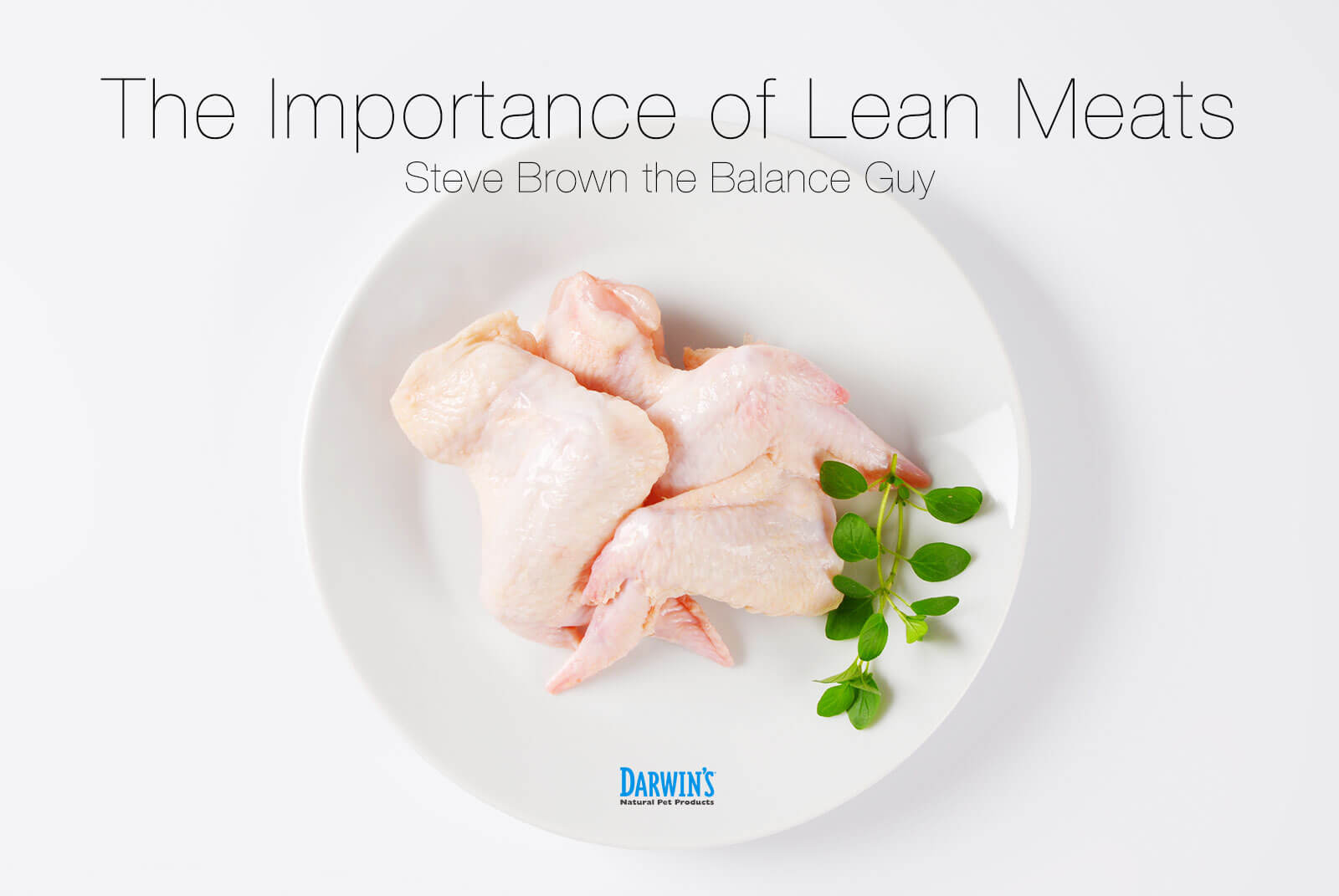

All Meat-Based Diets Require Lean Meats; Homemade and Commercial
Good meat-based recipes, certainly those intended to mimic The Ancestral Diet, start with lean bases and build from there. The base, the primary meat used in the recipe, is often ground meats in ruminant (beef, bison, lamb) recipes, and bone-in parts (necks, backs, carcasses) in poultry (chicken, turkey, duck) recipes. High-fat meats are not part of The Ancestral Diet. Wild prey is leaner with different fat profiles than feedlot-fed or even pasture-raised animals.
In this article I am going to look at one of the more popular feeding programs – the 80/10/10 diet — 80% meat (the base) 10% organs, and 10% bones –using fatty meats. The 70% lean ground beef and chicken backs with none of the fat and skin removed. And, lean meats, 90% lean ground beef and chicken backs with most of the skin and fat removed. I will compare them to the more demanding AAFCO and FEDIAF recommendations for protein, fat, amino acids, and the omega-6 fatty acid – linolenic acid. See Table 1.
Note: Using Atwater factors, I analyze meat-based recipes on caloric bases, not dry matter bases. The protein and fat content of chicken backs with bone vary so I am using typical numbers based upon tests conducted by Darwin’s and others. All nutrient content numbers of all foods are always approximate.
Table 1. Protein and fat content of 80/10/10 recipes using chicken backs with bone, skin and fat; chicken backs with ¾ of the skin and separable fat removed; 70% lean beef; and 90% lean beef, compared to the more demanding of AAFCO and FEDIAF standards.
Numbers in red do not meet recommendations for growth.
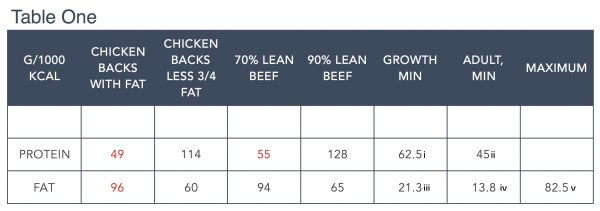
Part 1. Homemade Diets
When using fatty meats, the 80/10/10 recipes, and most homemade recipes I’ve analyzed, exceed recommendations for total fat, and do not have enough protein for puppies. Normally, one need look no further at a recipe like this. However, a closer look at the amino acid profile of the beef and the fatty acid profile of the chicken back 80/10/10 formula show how these recipes are far off scientific and ancestral standards.
The most worrisome part to me is that a base of 70% lean beef does not provide even one half of the minimum recommendations for tryptophan, an essential amino acid; the lack of which some studies suggest may lead to aggressive behaviors (Table 2).
Table 2. Amino acid profile of 80/10/10 recipe using 70 % lean beef and 90% lean beef, compared to AAFCO / FEDIAF recommendations. Numbers in red do not meet minimum recommendations for growth. g/ 1000 kcal.
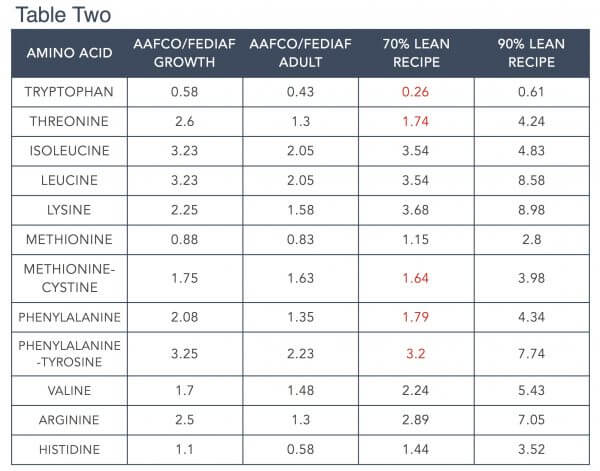
A base of chicken backs with none of the skin and fat removed exceeds all maximum recommendations for the omega-6 fatty acid – linoleic acid (LA), which studies suggest can be pro-inflammatory (Table 3).
Table 3. Total fat and LA content of recipes with chicken backs, and chicken backs with ¾ of the easily separated fat and skin removed, compared to maximums.

If the beef recipe specified 90% lean for growth and 85% lean for adults and the chicken recipe said to remove most of the easily separated fat and skin (the 50/50/50 guideline), we’d have a good base, and the recipes would show promise by meeting macro-nutrient and amino acid standards. However, we’d still have to balance the fats, calcium, phosphorus, minerals and vitamins.
Part 2. Commercial Raw Food Diet Feeders
Companies that produce a raw diet are almost always under price pressures. Lean meats are expensive even for the largest of these companies. Some companies succumb to the pressure and buy inexpensive fatty meats. On a pet food label, fat is often listed as a minimum. Less ethical companies can hide the true fat content.
When you go into a pet food store and see special sales on raw dog foods – for example: A 10 pound beef food chub for $30 or 10 pounds of chicken food for $20 – pause for a minute and think about the fat content. The $2.00 to $3.00 per pound price includes the retailer’s profit (usually 50% gross profit which means 2 times mark-up), the distributor’s profit (25%), freight and the manufacturer’s gross profit (50%). I’ve priced them many times and concluded that the manufacturers are probably using fatty, out-of-date beef, or chicken backs with all the skin and fat on them. You get what you pay for.
If you’re buying a commercial diet, look for leanness. You can usually tell by the kcal per ounce statement. This is often found on their website. If a fresh food diet, which includes moisture, not a dry food, contains more than 60 kcals per ounce it’s a high fat diet and I advise you avoid buying this food.
Part 3. Dry Food Feeders
Caution: adding more than 15% by weight of whole foods to typical dry foods may cause nutritional imbalances. I’m mostly concerned about growth foods (there are several) that contain just the minimum amounts of calcium necessary for healthy growth. For growth stages, it’s best to add meats with bone, but again, no more than 15%. Talk to your veterinarian before adding more than 15%.
Most dry foods lack protein when compared to The Ancestral Diet. If your veterinarian recommends that you boost the protein content of your dog or cat’s food, that does not mean just adding meat to the diet; it means adding lean meat. This is especially true for fat dogs and cats — add the meat with the most protein per kcal.
Table 4: RAW USDA and independent test data. Protein, % as fed and grams of protein per 1000 kcal. Note: 85% lean ground beef, with only 4.2% more protein as fed, has more than twice the amount of protein per 1000 kcal compared to 70% lean.
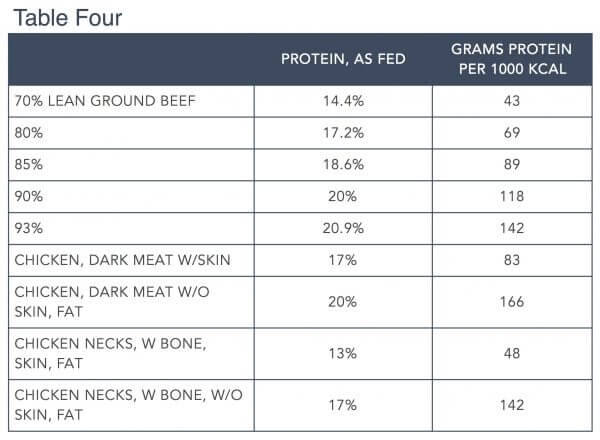
Part 4: The Adult Canine Recipes We Will Build in This Blog Series
We build the ruminant base with:
* 10 pounds, 90% lean ground beef
* 1 pound of beef heart
* 1 pound of beef liver.
We build the bone-in poultry base with
* 5 pounds chicken thighs, skin and separable fat removed
* 2.5 pounds chicken necks with bone, skin and fat
* 2.5 pounds chicken necks with bone, and the skin and separable fat removed.
* 1 pound chicken hearts
* 1 pound chicken livers
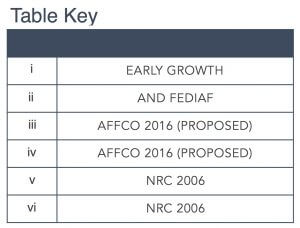

Steve Brown is a dog food formulator, researcher, and author on canine nutrition. In the 1990s he developed one of the leading low-calorie training treats, Charlee Bear® Dog Treats, as well as the first AAFCO-compliant raw dog food. Since 2003 he has focused on research and education. He is the author of two books on canine nutrition (See Spot Live Longer, now in its 8th printing, and Unlocking the Canine Ancestral Diet (Dogwise Publishing, 2010); and a 40-page booklet, See Spot Live Longer the ABC Way.



